

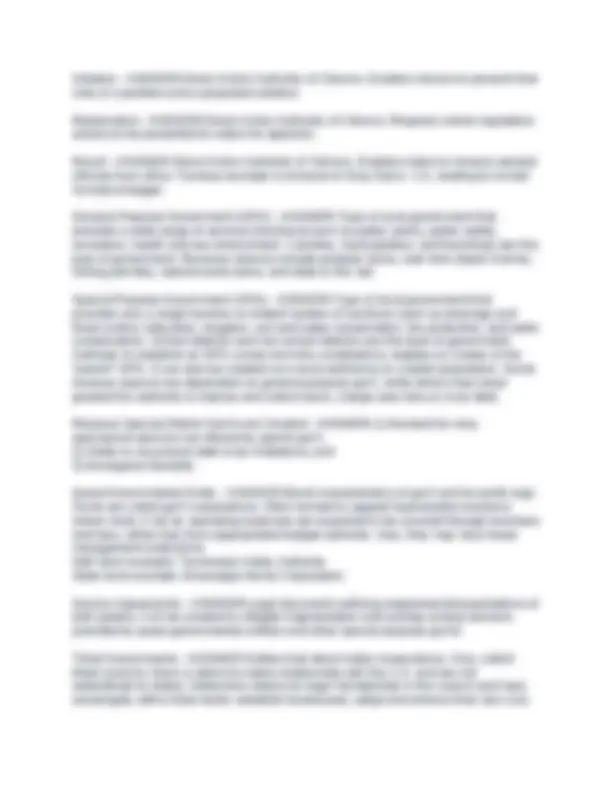
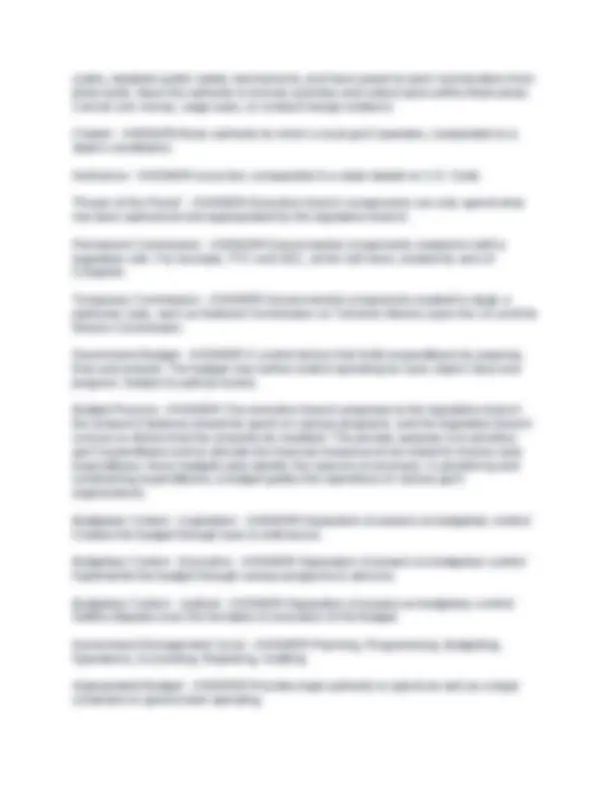

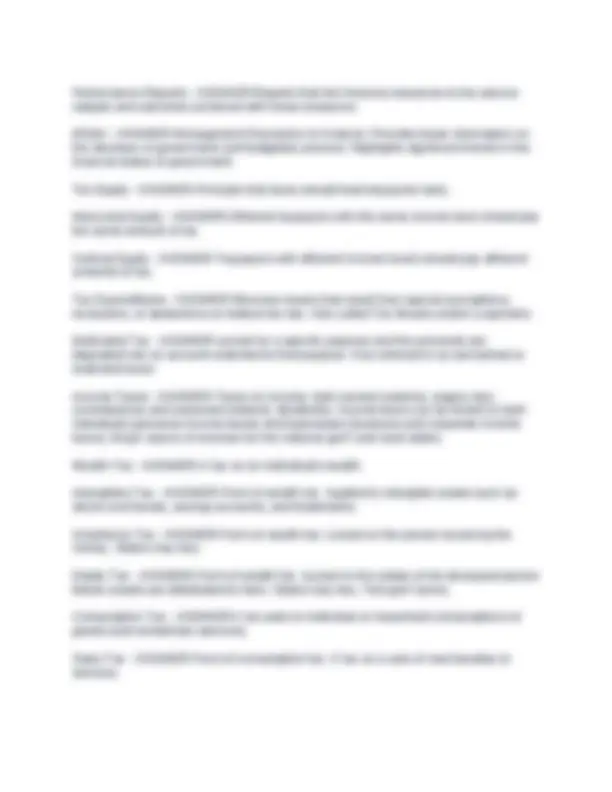
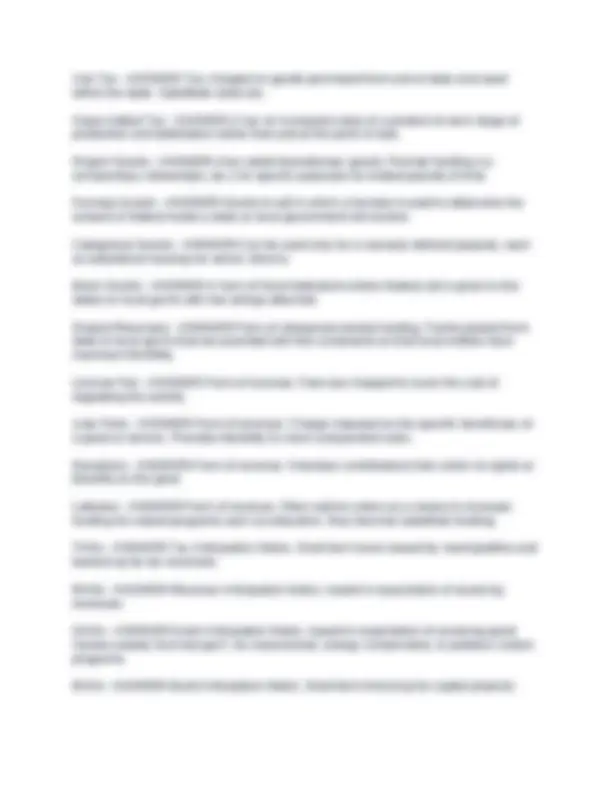
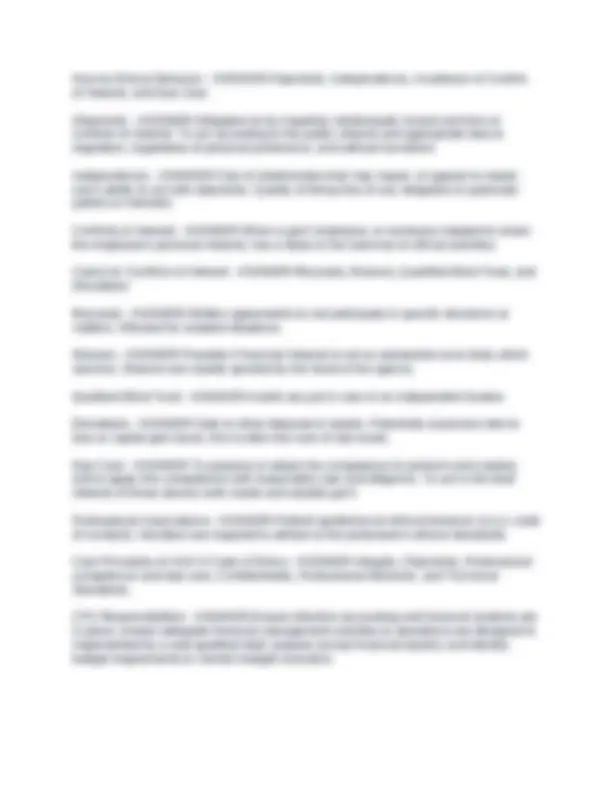

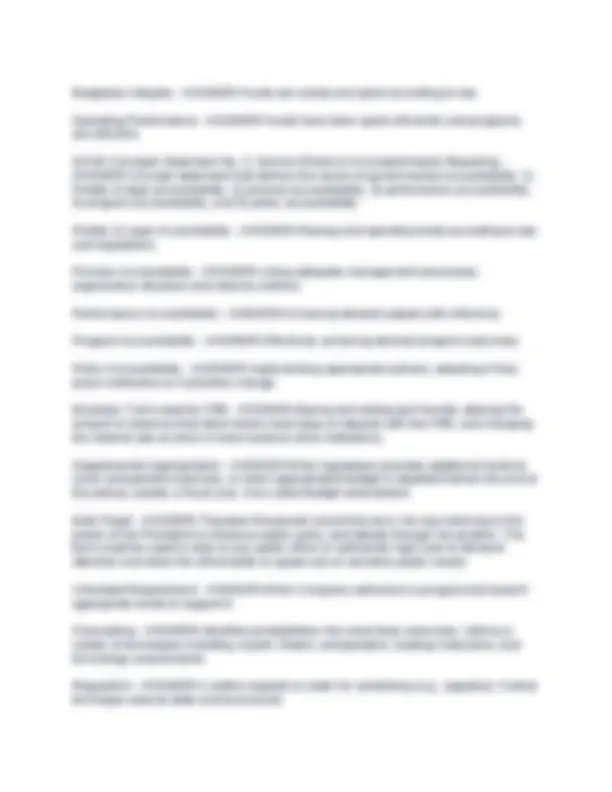
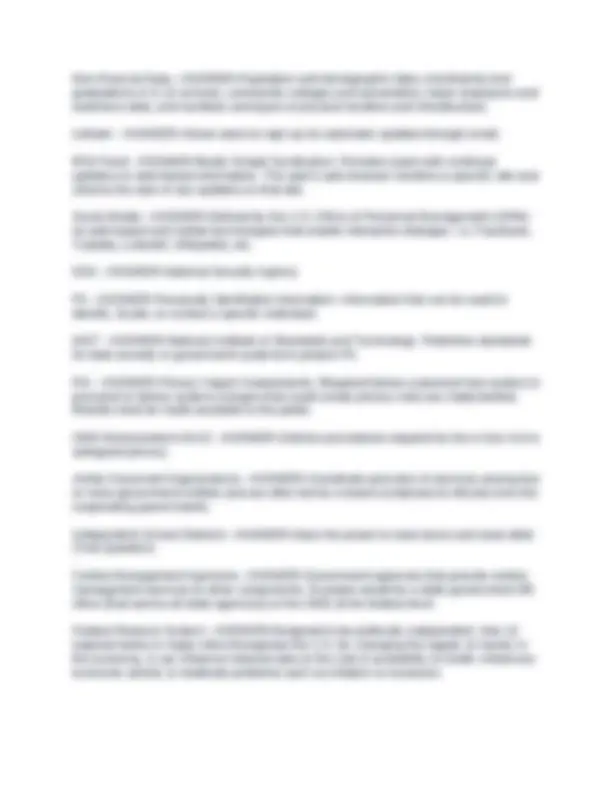
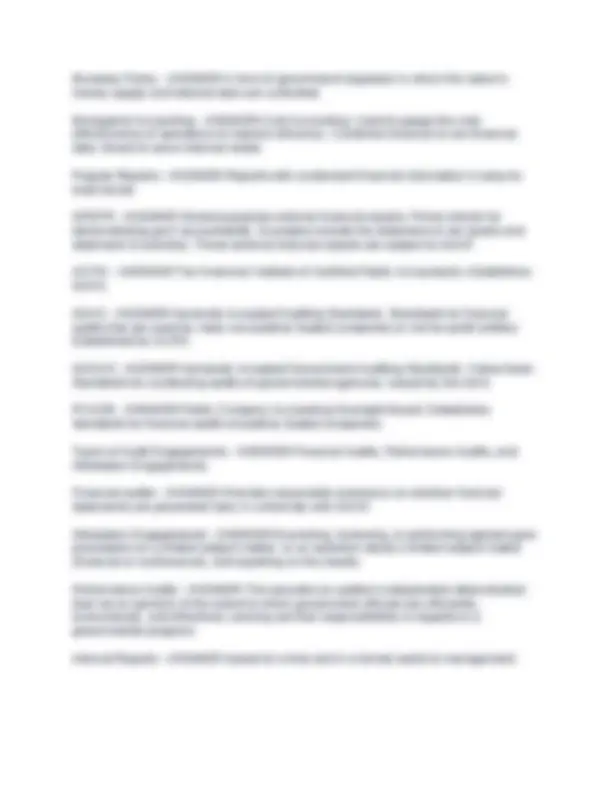



Study with the several resources on Docsity

Earn points by helping other students or get them with a premium plan


Prepare for your exams
Study with the several resources on Docsity

Earn points to download
Earn points by helping other students or get them with a premium plan
Community
Ask the community for help and clear up your study doubts
Discover the best universities in your country according to Docsity users
Free resources
Download our free guides on studying techniques, anxiety management strategies, and thesis advice from Docsity tutors
CGFM - Exam 1 Government Environment–Graded A
Typology: Exams
1 / 20

This page cannot be seen from the preview
Don't miss anything!













Government Sovereignty - ANSWER-Nat'l government can't be sued by states or by citizens w/out its permission. Government Authority - ANSWER-Derived from constitutions or charters (local versions of a constitution), statutes, executive orders & regulations. 3 Levels - ANSWER-1) National
Legal Constraints - ANSWER-Derived from constitutions, statutes, and ordinances. They can include limits on the type of tax, rate of tax, and tax collection purposes. Purpose Term Amount Process - ANSWER-Ways in which constitutions and charters specify whether the government can incur debt and limit government borrowing. (PTAP) Reserved Clause - ANSWER-Stems from the 10th Amendment to the U.S. Constitution. Powers not delegated to the Nat'l gov't, nor prohibited to the states, are reserved to the states and the people. Nat'l gov't can influence lower levels, but can't dictate the manner in which state & local gov't will operate. Areas of Overlap in Governmental Responsibilities - ANSWER-Nat'l and state gov'ts exercise authority in civil defense and the Nat'l Guard. For example, during peacetime, Nat'l Guard units fall under the direction of state governors and meet the needs of the state. During nat'l emergencies, these units are under command of the President, Commander in Chief. State and local gov'ts have some responsibility for traffic safety. All 3 levels impact public education. Grants - ANSWER-Money that is distributed to lower-level governments with the purpose of funding special projects. Laboratories of Democracy - ANSWER-Nickname given to state and local governments because they experiment with policies and procedures that are later adopted at the nat'l level. Performance Reporting - ANSWER-Example of upward influence (laboratory of democracy). U.S. gov't requirement created in the 90s for federal agencies. Process of collecting and distributing performance information; includes status reporting, progress measurement, and forecasting. Legislative - ANSWER-Passes laws. House of Representatives and Senate form legislative branch of Nat'l gov't. Includes Congressional Budget Office, the Library of Congress, Gov't Accountability Office, and Architect of the Capitol. Executive - ANSWER-Administers laws. Executes gov't programs. Includes the U.S. Departments of Education, Interior, and Defense. Judicial - ANSWER-Interprets laws and exercises judicial review over actions of the other branches. Municipal Governments - ANSWER-The lowest level of government and exercises authority over a municipality (i.e. city, town, village). Usually, the scope of its powers are
Initiative - ANSWER-Direct-Action Authority of Citizens. Enables citizens to present their view of a problem and a proposed solution. Referendum - ANSWER-Direct-Action Authority of Citizens. Requires certain legislative actions to be presented to voters for approval. Recall - ANSWER-Direct-Action Authority of Citizens. Enables voters to remove elected officials from office. Famous example is removal of Gray Davis - CA, leading to Arnold Schwarzenegger. General-Purpose Government (GPG) - ANSWER-Type of local government that provides a wide range of services [functions] such as public works, public safety, recreation, health and law enforcement. Counties, municipalities, and townships are this type of government. Revenue sources include property taxes, user fees (liquor license, fishing permits), sales/income taxes, and state & fed. aid. Special-Purpose Government (SPG) - ANSWER-Type of local government that provides only a single function or limited number of functions (such as drainage and flood control, education, irrigation, soil and water conservation, fire protection, and water conservation). School districts and non-school districts are this type of government. Authority to establish an SPG comes from the constitutions, statutes or charter of the "parent" GPG. It can also be created via a local ordinance or a ballot proposition. Some revenue sources are dependent on general-purpose gov't, while others have been granted the authority to impose and collect taxes, charge user fees or incur debt. Reasons Special-District Gov'ts are Created - ANSWER-1) Demand for new, specialized services not offered by parent gov't;
codes, establish public safety mechanisms, and have power to eject nonmembers from tribal lands. Have the authority to license activities and collect taxes within tribal areas. Cannot coin money, wage wars, or conduct foreign relations. Charter - ANSWER-Basic authority by which a local gov't operates, comparable to a state's constitution. Ordinance - ANSWER-Local law, comparable to a state statute or U.S. Code. "Power of the Purse" - ANSWER-Executive branch components can only spend what has been authorized and appropriated by the legislative branch. Permanent Commission - ANSWER-Governmental components created to fulfill a regulatory role. For example, FTC and SEC, at the nat'l level, created by acts of Congress. Temporary Commission - ANSWER-Governmental components created to study a particular case, such as National Commission on Terrorist Attacks Upon the US and the Warren Commission. Government Budget - ANSWER-A control device that limits expenditures by purpose, time and amount. The budget may further restrict spending by fund, object class and program. Subject to judicial review. Budget Process - ANSWER-The executive branch proposes to the legislative branch the amount it believes should be spent on various programs, and the legislative branch concurs or directs that the amounts be modified. The primary purpose is to prioritize gov't expenditures and to allocate the financial resources to be raised to finance said expenditures. Many budgets also identify the sources of revenues. In prioritizing and constraining expenditures, a budget guides the operations of various gov't organizations. Budgetary Control - Legislative - ANSWER-Separation of powers as budgetary control: Creates the budget through laws & ordinances. Budgetary Control - Executive - ANSWER-Separation of powers as budgetary control: Implements the budget through various programs & services. Budgetary Control - Judicial - ANSWER-Separation of powers as budgetary control: Settles disputes over the formation & execution of the budget. Government Management Cycle - ANSWER-Planning, Programming, Budgeting, Operations, Accounting, Reporting, Auditing Appropriated Budget - ANSWER-Provides legal authority to spend as well as a legal constraint on government spending.
Account Structures - ANSWER-Limit and classify gov't spending. May be based on program or object class. Program - ANSWER-The purpose of spending. Object Class - ANSWER-The specific goods or services that may be acquired. Sometimes referred to as line-item. Increases accountability, but decreases flexibility. Funds cannot be used for purposes not originally set for. Apportionments - ANSWER-Dispersal of budgetary authority to an agency or program by the central management agency--OMB--to support approved programs. Accounting - ANSWER-Used by gov't as a form of control., Planning, recording, analyzing, and interpreting financial information. Inhibit fraud and ensure funds are available when bills come due. Auditing - ANSWER-Final phase of gov't management cycle. Provides information that is used to hold gov't accountable and revise priorities during future planning efforts. External Audits - ANSWER-Provide objective review of gov't finances and performance. Relationship among Appropriations, Apportionments, and Allotments - ANSWER-In the federal government, the OMB apportions budgetary authority to various components of gov't. Each major component further distributes its apportionment within its own organization by issuing allotments to its organizational units. Appropriations - ANSWER-Budget laws passed by Congress. Reprogramming - ANSWER-The executive branch asks the legislative branch for approval to move funds from one appropriation line item to another. Traditional Management Model - ANSWER-Planning, organizing, directing, and controlling. Was expanded to emphasize the greater need for visibility and accountability in government. Planning - ANSWER-Identifying and prioritizing the mission, goals, and attainable objectives, as well as specific, sequenced actions to attain them. Keystone in the arch of public management. Organizing - ANSWER-Obtaining and deploying the human and other resources necessary to achieve planned objectives. Directing - ANSWER-Providing leadership and management to ensure human and other resources are deployed for maximum results.
Controlling - ANSWER-Systematically checking work against the plan, identifying variances and making adjustments to previous steps as required. Mission - ANSWER-Ideal statement of what the organization hopes to achieve. Goal - ANSWER-Broad statement of purpose for a particular program within the agency. Objective - ANSWER-Measurable accomplishment to be achieved within a specific period of time. Programming - ANSWER-Follows Planning. Primary purpose is to determine the most cost-effective means for accomplishing goals and objectives. Prosaic and deadline- driven. Budgeting - ANSWER-Central control device in the gov't management cycle. Operating Budgets - ANSWER-Covers a limited period of usually one to two years. Specifies planned revenues and expenditures throughout the budget period. Cash-flow Budget - ANSWER-Purpose is to help plan the timing of cash receipts and expenditures so funds will actually be available when it's time to make a payment. Capital Budget - ANSWER-Covers big ticket items that will support governmental operations for several years, and that may also be acquired over a period of several years. Operations - ANSWER-All activities needed to achieve program objectives. During this phase, actual gov't services are delivered. Internal Controls - ANSWER-To ensure assets are safeguarded and used for the intended purpose. Minimizes the risk of loss, fraud and mismanagement. Critical during the Operations phase of the gov't management cycle. Also referred to as management controls. Reporting - ANSWER-Primary purpose is to communicate accomplishments and resources expended. It is essential to accountability. GASB - ANSWER-Governmental Accounting Standards Board. Defines GAAP for state and local gov'ts; tribal gov'ts; and U.S. Territories, trusts, and commonwealths. FASAB - ANSWER-Federal Accounting Standards Advisory Board. Defines GAAP for entities of the national gov't. FASB - ANSWER-Financial Accounting Standards Board. Defines GAAP for private sector entities.
Use Tax - ANSWER-Tax charged on goods purchased from out-of-state and used within the state. Substitute sales tax. Value-Added Tax - ANSWER-A tax on increased value of a product at each stage of production and distribution rather than just at the point of sale. Project Grants - ANSWER-Also called discretionary grants. Provide funding (i.e. scholarships, fellowships, etc.) for specific purposes for limited periods of time. Formula Grants - ANSWER-Grants-in-aid in which a formula is used to determine the amount of federal funds a state or local government will receive. Categorical Grants - ANSWER-Can be used only for a narrowly defined purpose, such as subsidized housing for senior citizens. Block Grants - ANSWER-A form of fiscal federalism where federal aid is given to the states or local gov'ts with few strings attached. Shared Revenues - ANSWER-Form of intergovernmental funding. Funds passed from state to local gov'ts that are provided with few constraints so that local entities have maximum flexibility. License Fee - ANSWER-Form of revenue. Fees are charged to cover the cost of regulating the activity. User Fees - ANSWER-Form of revenue. Charge imposed on the specific beneficiary of a good or service. Provides flexibility to cover unexpected costs. Donations - ANSWER-Form of revenue. Voluntary contributions that confer no rights or benefits on the giver. Lotteries - ANSWER-Form of revenue. Often sold to voters as a means to increase funding for valued programs such as education. May become substitute funding. TANs - ANSWER-Tax Anticipation Notes. Short-term loans issued by municipalities and backed up by tax revenues. RANs - ANSWER-Revenue Anticipation Notes. Issued in expectation of receiving revenues. GANs - ANSWER-Grant Anticipation Notes. Issued in expectation of receiving grant monies usually from fed gov't. for mass-transit, energy conservation, & pollution control programs. BANs - ANSWER-Bond Anticipation Notes. Short-term financing for capital projects.
Refunding - ANSWER-When gov'ts issue new debt that allows them to pay off existing debt at more favorable interest rates. Advanced Refunding - ANSWER-The proceeds from the new debt issue are not directly applied to the old debt. Rather, the new debt proceeds are used to buy securities that are placed in escrow; interest from the escrow acct is used to retire the old debt. Covenants - ANSWER-Legal requirements pertaining to a specific bond issue. Typically defines the maturity date and revenue stream that will be used to repay the debt, the interest rate and repayment schedule. The 3-E's of Government Debt - ANSWER-Equity, Effectiveness, and Efficiency. Equity - ANSWER-1 of 3 E's of Gov't Debt. Repayment of debt should provide sufficient funds for the project. Effectiveness - ANSWER-1 of 3 E's of Gov't Debt. The debt issue should provide sufficient funds for the project. Efficiency - ANSWER-1 of 3 E's of Gov't Debt. Loaned funds should be obtained at the lowest cost possible relative to the risk. Government Bond - ANSWER-Legal contract to pay face value of the bond at maturity (a fixed date in the future). The issuer pays the interest at a fixed rate. General Obligation bond - ANSWER-Secured by the full revenue base of the issuer. Also called "full faith and credit" bonds because the responsible gov't agrees to repay the debt from any and all revenue sources. Term Bond - ANSWER-Large block of bonds maturing in a single year, usually many years (often 25 or 30) after issuance. Serial Bond - ANSWER-Features maturities every year, annually or semiannually, over a period of years. Warrant - ANSWER-An order by an authorized executive official that directs the treasury to pay a specific sum to the bearer. Similar to a check. Notes - ANSWER-Support long-term financial management. Similar to bonds but are usually issued for a shorter period of time. Due to short maturity period, there are no periodic interest payments. Capital Leases - ANSWER-A contractual agreement allowing one party (the lessee) to use the assets of another party (the lessor); assets are transferred to the gov't at the end of the lease period; accounted for like a debt-financed purchase by the lessee.
Keys to Ethical Behavior - ANSWER-Objectivity, Independence, Avoidance of Conflict of Interest, and Due Care. Objectivity - ANSWER-Obligation to be impartial, intellectually honest and free of conflicts of interest. To act according to the public interest and appropriate laws & regulation, regardless of personal preference, and without favoritism. Independence - ANSWER-Free of relationships that may impair, or appear to impair, one's ability to act with objectivity. Quality of being free of any obligation to particular parties or interests. Conflicts of Interest - ANSWER-When a gov't employee, or someone imputed to share the employee's personal interest, has a stake in the outcome of official activities. Cures for Conflicts of Interest - ANSWER-Recusals, Waivers, Qualified Blind Trust, and Divestiture Recusals - ANSWER-Written agreements to not participate in specific decisions or matters. Effected for isolated situations. Waivers - ANSWER-Possible if financial interest is not so substantial as to likely affect services. Waivers are usually granted by the head of the agency. Qualified Blind Trust - ANSWER-Assets are put in care of an independent trustee. Divestiture - ANSWER-Sale or other disposal of assets. Potentially expensive due to loss or capital gain taxes, this is often the cure of last resort. Due Care - ANSWER-To possess or obtain the competence to perform one's duties, and to apply this competence with reasonable care and diligence. To act in the best interest of those served, both inside and outside gov't. Professional Associations - ANSWER-Publish guidelines to ethical behavior (a.k.a. code of conduct); members are required to adhere to the profession's ethical standards. Core Principles of AGA'S Code of Ethics - ANSWER-Integrity, Objectivity, Professional competence and due care, Confidentiality, Professional Behavior, and Technical Standards. CFO Responsibilities - ANSWER-Ensure effective accounting and financial systems are in place; ensure adequate financial management activities & operations are designed & implemented by a well-qualified staff; prepare annual financial reports; and identify budget requirements & monitor budget execution.
Financial Management System (FMS) - ANSWER-Organized means for the collection, processing, transmission and dissemination of financial information. May be automated or manual. Benefits of Effective FMS - ANSWER-Promotes accountability & efficiency and supports decision-making. FFMIA of 1996 - ANSWER-Federal Financial Management Improvement Act of 1996. Enacted to require all agencies to maintain systems that comply with federal financial management system requirements, federal accounting standards and the U.S. Standard General Ledger at the transaction level. E-Government - ANSWER-Involves the use of strategies and technologies to transform government(s) by improving the delivery of services and enhancing the quality of interaction between the citizen/consumer within all branches of government. Include: G2C, G2B, and G2G. Telework - ANSWER-Working from home or other locations. Improves productivity due to fewer interruptions. Plays a role in continuity of operations (i.e. natural disasters). Means for achieving decentralized operations. Fraud Prevention Programs - ANSWER-Fraud Risk Assessment, Anti-fraud Policies, Education & Training, Monitoring, and Forensic Auditing. Can help mitigate the risks associated with financial systems. Data Mining - ANSWER-Uses a supplementary computer module to detect suspicious patterns in data. Used to detect fraudulent transactions. ERPs - ANSWER-Enterprise Resource Planning Systems. Attempt to integrate all data and processes of an organization into a unified system to help manage and assess complex, interrelated activities. Key Features of an ERP - ANSWER-A common shared database; one-time entry of shared data; and/or automated integration & sharing of data across business functions. COOP - ANSWER-Continuity of Operations. Efforts taken by an organization to ensure it can sustain essential operations regardless of planned or unplanned incidents. Key Features of a COOP Plan - ANSWER-Succession planning, preparation of alternate facilities and live tests are key features of a COOP plan. Statement of Federal Financial Accounting Concepts No. 1, Objectives of Federal Financial Reporting - ANSWER-Concept statement created by FASAB that addresses governmental accountability. According to this statement, governments are accountable for the following: budgetary integrity, operating performance, stewardship, and internal controls.
Encumbrance - ANSWER-Charge against specific accounts. Control technique used at state and local levels. Management Reserve - ANSWER-When each level in the chain of command retains a small portion of budgetary authority before allotting it to lower levels. These reserve funds provide some operational flexibility for authorized purposes. Financial Accounting - ANSWER-Designed to serve the needs of external users and is the form of accounting that leads to preparation of external financial reports. Used to determine results of operations & changes in net position. Forms the backbone of the accounting phase in the mgt. cycle. Budgetary Accounting - ANSWER-Helps entities remain within legal budget. Tracks commitments (requisitions), obligations (encumbrances), and expenditures by purpose, time and amount. Forms the backbone of the accounting phase in the mgt. cycle. Balanced Budget - ANSWER-Annual budget in which expenditures equal revenues. House - ANSWER-An official assembly having legislative powers. All appropriations bills must originate here. Senate - ANSWER-An official assembly having the power to debate and pass laws. GAO - ANSWER-Government Accountability Office. Establishes government auditing standards. The Fourth Estate - ANSWER-Another term for media or the free press because they provide unofficial checks and balances on the three branches of government. Critical to government accountability. Solvency - ANSWER-Ability to generate future revenues and meet long-term obligations. Sustainability - ANSWER-Ability and willingness of the gov't. to meet financial obligations as they come due and meet service commitments. GFOA - ANSWER-Government Finance Officers Association Benchmarking - ANSWER-Comparing indicators, such as ratios, across entities or across different fiscal years. Benefit of Sustainability Assessment - ANSWER-Alerts public officials and citizens to the need for policy changes before the "fix" becomes too costly to implement.
Techniques used to Demonstrate Accountability - ANSWER-Oversight hearings, evaluations, reports and audits. Governmental Long-term Accountability - ANSWER-Stewardship of heritage assets, economic security, and defense of freedom. OPEBs - ANSWER-Other post-employment benefits. For example, health insurance and life insurance for retirees. GASB Statement 68 - ANSWER-Designed to improve accounting and reporting for defined-benefit pension plans. Public Law 107-347 - ANSWER-The E-Government Act. Requires federal agencies to use Internet-based information technology to enhance citizen access to government information and services, and also requires numerous safeguards to personal privacy. OEG - ANSWER-Office of Electronic Government. Established within the Office of Management & Budget (OMB) by the E-Gov't Act. Responsibilities of OEG - ANSWER-Assist all federal agencies in developing system architecture to support electronic gov't; ensure interconnectivity and interoperability across gov't websites; sponsor activities to engage the general public in developing programs and information portals that serve the needs of the public; and develop cost- effective security measures for web-based information. GSA - ANSWER-General Services Administration. Works closely with the OMB's OEG by providing supply schedules to help all federal agencies enhance their internet-based initiatives. Interconnectivity - ANSWER-Key to successful online access. Allows for rapid integration of information across the websites of different government agencies. Can improve crisis preparedness and response. Performance Criteria for e-Gov Initiatives - ANSWER-Impact of e-Gov in helping agencies fulfill strategic goals; customer satisfaction and customer service; productivity in providing e-Gov services; and incorporation of commercial best practices. Example of e-Gov at Federal Level - ANSWER-Electronic Filing of tax returns, or IRS e- file; USAspending.gov, which provides immediate, transparent information on federal contracts. E-reporting - ANSWER-Access to gov't financial, non-financial, and performance data through a website.
Monetary Policy - ANSWER-A form of government regulation in which the nation's money supply and interest rates are controlled. Managerial Accounting - ANSWER-Cost Accounting. Used to gauge the cost- effectiveness of operations & improve efficiency. Combines financial & non-financial data. Meant to serve internal needs. Popular Reports - ANSWER-Reports with condensed financial information in easy-to- read format. GPEFR - ANSWER-General-purpose external financial reports. Prime vehicle for demonstrating gov't accountability. Examples include the statement of net assets and statement of activities. These external financial reports are subject to GAAP. AICPA - ANSWER-The American Institute of Certified Public Accountants. Establishes GAAS. GAAS - ANSWER-Generally Accepted Auditing Standards. Standards for financial audits that are used by many non-publicly traded companies or not-for-profit entities. Established by AICPA. GAGAS - ANSWER-Generally Accepted Government Auditing Standards. Yellow book. Standards for conducting audits of governmental agencies. Issued by the GAO. PCAOB - ANSWER-Public Company Accounting Oversight Board. Establishes standards for financial audits of publicly traded companies. Types of Audit Engagements - ANSWER-Financial Audits, Performance Audits, and Attestation Engagements. Financial audits - ANSWER-Provides reasonable assurance on whether financial statements are presented fairly in conformity with GAAP. Attestation Engagements - ANSWER-Examining, reviewing, or performing agreed-upon procedures on a limited subject matter, or an assertion about a limited subject matter (financial or nonfinancial), and reporting on the results. Performance Audits - ANSWER-This provides an auditor's independent determination (but not an opinion) of the extent to which government officials are efficiently, economically, and effectively carrying out their responsibilities in regards to a governmental program. Internal Reports - ANSWER-Issued at a time and in a format useful to management.
External Reports - ANSWER-Formal and required at the end of the reporting period. The format and content of external reports may be prescribed by GAAP, legislation or covenants. Real Property Tax - ANSWER-Tax base is the value of the property. Greatest challenge is appraisal and subsequent assessment of property values. Equalization - ANSWER-The raising or lowering of assessed value for tax purposes in a particular county or taxing district to make them equal to assessments in other counties or districts. Excise Tax - ANSWER-Luxury or sin tax. Applied to the consumption of a particular type of good, or to participation in a certain type of activity. Usually paid when purchases are made and may even be included in the price of the product, such as on gasoline. Intergovernmental Contracts - ANSWER-1st form of intergovernmental financing. Voluntary arrangements entered into for the mutual benefit of both entities. Revenue Bond - ANSWER-Supported only through revenues generated by projects that are funded with the help of the original bond issue. Secures principal and interest payments on gov't debt. More risk, higher interest rates. Bond Insurance - ANSWER-Helps lower interest rates and reserves; may assist in issuance of bonds. Debt Guarantee - ANSWER-Guarantee that, should a state's local entity default on interest or principal payments, the state will use its full financial resources to fulfill the obligation. Benefit Received - ANSWER-The theory that consumers should contribute taxes in proportion to the benefits received from the services of the government. Ability to Pay - ANSWER-Principle of taxation in which those with higher incomes pay more taxes than those with lower incomes, regardless of the number of government services they receive.